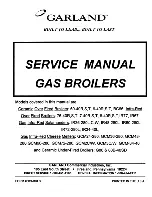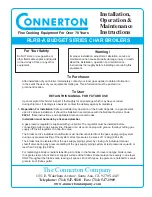
30
speed. Do not operate summer exhaust fan. Close
fireplace dampers.
4.
Place in operation the appliances being inspected.
Follow the manufacturer’s instructions for lighting
each appliance. Adjust thermostat so appliance
will operate continuously.
5.
Check the pressure at a pressure tap located 12
in. above the bottom joint of the first vertical vent
pipe. Pressure should be anywhere between -0.01
and -0.08 in. WC.
6.
After it has been determined that each appliance
remaining connected to the common venting sys-
tem properly vents when tested as outlined above,
return doors, windows, exhaust fans, fireplace
dampers and other gas burning appliances to their
previous conditions of use.
7.
Any improper operation of the common venting
system should be corrected so that the installation
conforms with the NFGC (U.S.) or B149.1
(Canada). When re-sizing any portion of the com-
mon venting system, the common venting system
should be re-sized to approach the minimum size
as determined using the appropriate tables in Ap-
pendix G in the NFGC (U.S.) or B149.1 (Canada).
Horizontal Through-the-Wall Venting
(Category III)
Installation
These installations utilize the heater-mounted blower
to vent the combustion products to the outdoors.
Combustion air is taken from inside the room and the
vent is installed horizontally through the wall to the out-
doors. Adequate combustion and ventilation air must
be supplied to the equipment room in accordance with
the NFGC (U.S.) or B149.1 (Canada).
Fig. 25: Horizontal Through-the-Wall Venting
(Category III)
The total length of the horizontal through-the-wall flue
system should not exceed 70 equivalent ft in length. If
horizontal run exceeds 70 equivalent ft, an appropri-
ately sized extractor must be used. Each elbow used
is equal to 10 ft of straight pipe. This will allow installa-
tion in one of the four following arrangements:
•
70’ of straight flue pipe
•
60’ of straight flue pipe and one elbow
•
50’ of straight flue pipe and two elbows
•
40’ of straight pipe and three elbows
The vent cap is not considered in the overall length of
the venting system.
The vent must be installed to prevent flue gas leakage.
Care must be taken during assembly to ensure that all
joints are sealed properly and are airtight. The vent
must be installed to prevent the potential accumulation
of condensate in the vent pipes. It is required that:
1.
The vent must be installed with a slight downward
slope of not more than 1/4 inch per foot of hori-
zontal run to the vent terminal.
2.
The vent must be insulated through the length of
the horizontal run.
For installations in extremely cold climate, it is re-
quired that:
1.
The vent must be installed with a slight upward
slope of not more than 1/4 inch per foot of hori-
zontal run to the vent terminal. In this case, an ap-
proved condensate trap must be installed per ap-
plicable codes.
2.
The vent must be insulated through the length of
the horizontal run.
Termination
The flue direct vent cap MUST be mounted on the ex-
terior of the building. The direct vent cap cannot be
installed in a well or below grade. The direct vent cap
must be installed at least 1 ft above ground level and
above normal snow levels. The Raypak-approved
stainless steel flue direct vent cap must be used (sales
order option D-15).
WARNING:
No substitutions of flue pipe or vent
cap material are allowed. Such substitutions would
jeopardize the safety and health of inhabitants.
Содержание Hi Delta 302A
Страница 2: ...2...
Страница 38: ...38 Fig 34 High Low Gas Pressure Switch Fig 35 Fan Proving Switch Fig 36 Blocked Vent Switch...
Страница 44: ...44 Wiring Diagram...
















































